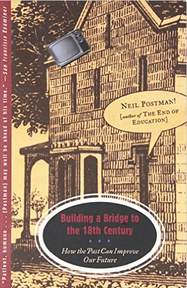How the past can improve our future
by Neil Postman
1999, First Vintage Books, 193 pages
 Neil Postman, longtime professor and eventual chair of the department of culture and communication at New York University, sadly died in 2003 at the age of 72. Bridge is his final book, and it deals with the same universal themes found in his earlier 20-odd works: language, reason, education, childhood, and the idea of progress. [I also want to state that this book, as so many others, I decided to read and review thanks to reference from my dear mother, who was always in her own orbit politically and managed, eventually, with works such as these, to liberate my literal cause-orientation from its familiar strait jackets.]
Neil Postman, longtime professor and eventual chair of the department of culture and communication at New York University, sadly died in 2003 at the age of 72. Bridge is his final book, and it deals with the same universal themes found in his earlier 20-odd works: language, reason, education, childhood, and the idea of progress. [I also want to state that this book, as so many others, I decided to read and review thanks to reference from my dear mother, who was always in her own orbit politically and managed, eventually, with works such as these, to liberate my literal cause-orientation from its familiar strait jackets.]
Despairing over post-modernists who claim words don’t stand for anything real, he makes a case for reading and writing. Indeed, he feels if we don’t come up with a meaningful narrative for our world, we’re toast.
It is no accident, Postman is a huge fan of the two Thomases: Thomas Jefferson and Thomas Paine, particularly Paine.
Note: Thomas Paine wrote Common Sense and The Crisis. Common Sense sold as many as 600,000 copies, which would be equivalent to a run of 60 million copies in the United States today.
During the 18th century we were sowing the seeds for the end of monarchy and, eventually, slavery. Dr. Postman states that “men of the mind” in those heady days thought knowledge should be useful. Such Renaissance Men were known as philosophes, i.e. philosophers using their minds for great and just social causes.
Now consider the modern era, and the so-called information revolution. The pervasive imagery of video and computer media work often to undercut the logical, serial narrative form of print. Reading, books in particular, requires active intellect, constantly evaluating statements, considering context, weighing consistencies, etc.
Too often we succumb to the easier means of getting information… from perceptual streams of video images and sounds, serving to reinforce the perceptual-emotional method of awareness: “see something, have an immediate, often extreme emotion one way or the other.”
For example, a large number of Americans see footage of the World Trade Center towers falling and have an immediate animosity toward Arab men. Alternative explanations to the official story, no matter how logically unassailable, are simply blocked from consideration. A society relying on emotions bred from controlled media images is Orwellian… and doomed.
Dr. Postman also has insightful observations on the loss of childhood to technology. He doesn’t “rail against the machine,” so much as ask questions of the necessity of every shiny new super wombat thunderpig widget that comes along:
“What is the problem to which the supersonic jet is the solution?” — pg.43.
Do we want a world in which, according to Thoreau, “All our inventions are but improved means to an unimproved end?”
The main message:
“With this in mind [keeping the American dream alive], I suggest we turn our attention to the 18th century. It is there, I think, we find the ideas that offer a humane direction to the future, ideas that we can carry with confidence and dignity across the bridge to the 21st century.” — pg. 17
 I submit the central ideas of the 18th century are practical reason and political liberty. We can dust them off, add some bells and whistles fitting to the times, and apply them anew. I think the Good Doctor would be proud.
I submit the central ideas of the 18th century are practical reason and political liberty. We can dust them off, add some bells and whistles fitting to the times, and apply them anew. I think the Good Doctor would be proud.
This post has been read 2450 times!

